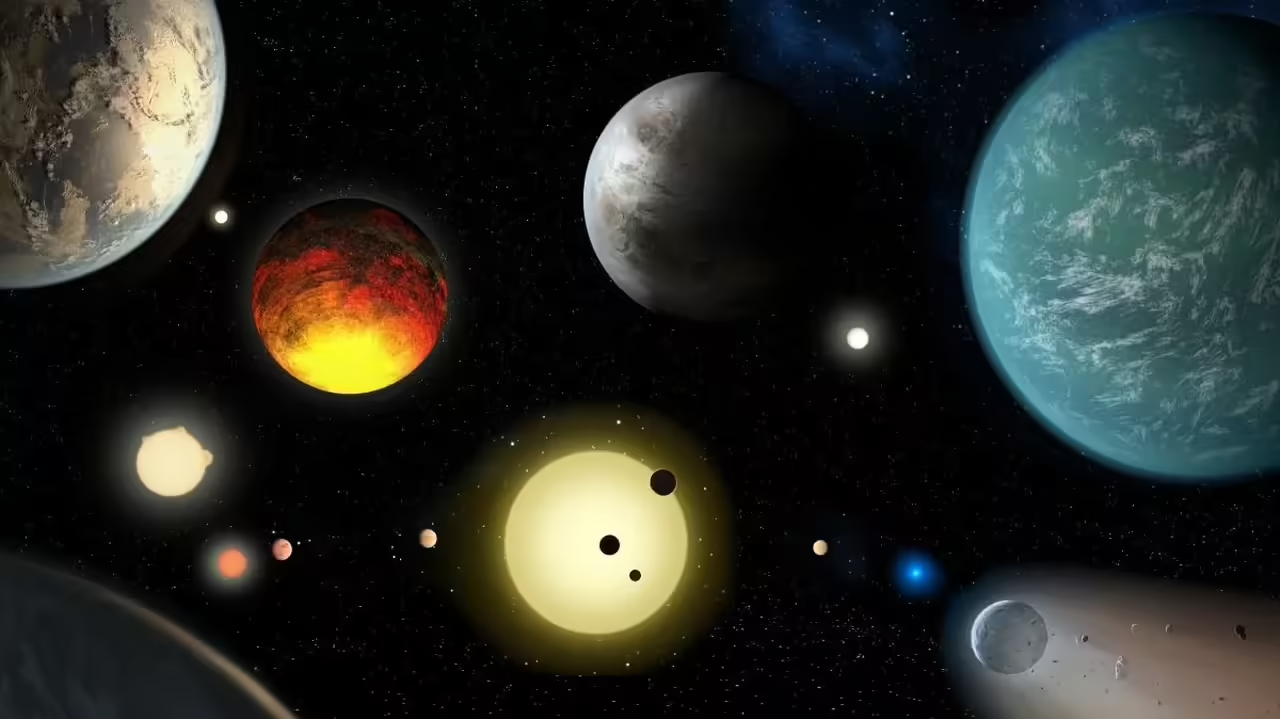
Scientists have long looked to the heavens and wondered if life exists on other planets beyond our solar system. The discovery of the TRAPPIST planets, an exciting star system full of promise, has revolutionized our understanding of the cosmos and brought us one step closer to answering that intriguing question.
The name “TRAPPIST” comes from the TRAPPIST telescope (TRAnsiting Planets and PlanetesImals Small Telescope), located at the La Silla Observatory in Chile. It was thanks to this instrument and a team of astronomers led by Michaël Gillon, from the University of Liège in Belgium, that the amazing discovery was made in 2016.
The TRAPPIST system lies approximately 40 light-years away from Earth, in the constellation Aquarius. What makes these planets so special is that they orbit an ultra-cool dwarf star called TRAPPIST-1, which is much smaller and cooler than our Sun. In this system, three planets were initially identified, but with additional observations, a total of seven planets were discovered in orbit around TRAPPIST-1.
What makes these planets particularly interesting is their location in the “habitable zone” of their star. The habitable zone is a region around a star where conditions could allow liquid water to exist on a planet’s surface. Since liquid water is essential for life as we know it, this has generated great excitement in the scientific community and captured the imagination of the general public.
The TRAPPIST planets are rocky, similar in size to Earth and Venus, suggesting that they may have a similar composition and internal structure to the terrestrial planets in our own solar system. Because of their relative proximity to Earth and their potentially habitable characteristics, these worlds have become objects of intense research and speculation.
Observations so far have revealed fascinating features of the TRAPPIST planets. For example, some of them show tidal synchronization, meaning that they always have the same face toward their star, just as the Moon always shows the same face toward Earth. This could have important implications for the climate and habitability conditions on these worlds.
The TRAPPIST system presents an intriguing peculiarity: the planets are close enough together that an observer on the surface of one planet could see the other planets in the sky more prominently than the Moon does on Earth. It would be an impressive sight, with planetary neighbors filling much of the horizon.
The study and understanding of the TRAPPIST planets is ongoing. Scientists are using a variety of techniques, such as analyzing the atmospheres of these planets by spectroscopy, to look for possible signs of life or habitable conditions. Computer simulations are also being performed to model the climatic and geological characteristics of these worlds and better understand their potential habitability.
The search for life beyond Earth is an exciting and complex topic, and the TRAPPIST planets have sparked unprecedented interest in the scientific community and the general public. The possibility that liquid water and conditions favorable for life exist on these planets raises fundamental questions about our place in the universe and our understanding of cosmic diversity.
However, it is important to note that, so far, we have no direct evidence of life on the TRAPPIST planets or anywhere else outside of Earth. The search for extraterrestrial life remains a complex challenge and we are in the early stages of our exploration.
The discovery of the TRAPPIST planets and ongoing research show us that our universe is a vast and amazing place, full of possibilities. These distant worlds invite us to reflect on the existence of life elsewhere and push us to continue to investigate and explore beyond our planetary boundaries.
The James Webb Space Telescope (Webb Telescope)
The James Webb Space Telescope, also known as the Webb Telescope, is one of the most ambitious and highly anticipated projects in the field of astronomy and space exploration. This telescope, which is scheduled for launch in 2021, represents a significant leap in our space observation capabilities and is expected to revolutionize our understanding of the universe.
The Webb Telescope is an international collaboration between NASA, the European Space Agency (ESA) and the Canadian Space Agency (CSA). It is the successor to the Hubble Space Telescope and its development has been a process of more than two decades. The telescope will be named after James E. Webb, the NASA administrator who played a key role in the Apollo program and in advancing space exploration.
One of the most outstanding features of the Webb Telescope is its primary mirror, which has an aperture of 6.5 meters in diameter, more than twice the size of the Hubble mirror. This mirror is an innovative design composed of 18 hexagonal segments that will be deployed once the telescope is in space. This segmented mirror technology will allow the Webb Telescope to capture significantly more light and observe fainter and more distant objects than ever before.
Aside from its primary mirror, the Webb Telescope is equipped with a variety of state-of-the-art scientific instruments ranging from infrared to visible light. These instruments will enable groundbreaking research in areas such as star and planet formation, the search for exoplanets, the study of galaxy evolution, and the exploration of the origins of the universe.
The importance of the Webb Telescope in space exploration is significant. Its superior capabilities and its ability to observe in the infrared spectrum will allow it to study objects and phenomena that have been difficult to detect or understand until now. For example, it will be able to analyze the atmosphere of exoplanets for signs of life and better understand how planetary systems form.
The Webb Telescope will play a crucial role in the search for answers to fundamental questions about the origin and evolution of the universe. With its ability to observe distant objects and examine the early universe, it is expected to provide valuable information about the formation of the first stars and galaxies, the nature of dark matter and dark energy, and insights into how our own solar system developed.
Atmospheric Studies of TRAPPIST Planets
The James Webb Space Telescope will play a key role in studying the atmospheres of the TRAPPIST planets and searching for signs of habitability on these distant worlds. Through its highly sensitive scientific instruments and its ability to observe in the infrared spectrum, the Webb Telescope will make it possible to analyze the atmospheric compositions of these planets and obtain crucial information about their potential habitability.
One of the Webb Telescope’s key instruments for this purpose is the Integral Field Imaging Spectrograph (NIRSpec). This instrument is specially designed to study the infrared light from celestial objects and will provide precise data on the chemical characteristics of the atmospheres of the TRAPPIST planets.
By observing light passing through the atmosphere of a transiting planet in front of its star, the Webb Telescope will be able to detect spectral signatures that indicate the presence of different elements and molecules in the atmosphere. This is possible because different compounds absorb and emit light at specific wavelengths. By analyzing these spectral signatures, scientists can determine the chemical composition of atmospheres and look for elements and molecules that could be indicators of biological processes or habitability.
Understanding atmospheric compositions is critical to determining a planet’s habitability. Atmospheres can influence temperature, pressure, and the presence of essential gases such as oxygen and carbon dioxide. These conditions are fundamental to the development and maintenance of life as we know it. By studying the atmospheres of TRAPPIST planets, the Webb Telescope can help answer crucial questions about whether these worlds could harbor life.
In addition to atmospheric compositions, the Webb Telescope can also provide valuable information on other atmospheric aspects, such as the presence of clouds, thermal structure, and atmospheric dynamics. These data will help scientists better understand the climatic environments and habitable conditions on the TRAPPIST planets.
The importance of understanding the atmospheric compositions of TRAPPIST planets is that they allow us to assess their potential habitability and determine whether they are suitable for life. By identifying key molecules in the atmosphere, such as water, oxygen, methane, or other gases related to biological processes, we can obtain clues about the existence of extraterrestrial life or the ability to support life in the past or present.
Implications for the Search for Extraterrestrial Life
The James Webb Space Telescope findings on the TRAPPIST planets have significant implications for the search for extraterrestrial life in other star systems. These discoveries may provide crucial information about the existence of habitable conditions and the possible presence of life on other worlds.
First, by studying the atmospheres of TRAPPIST planets, the Webb Telescope can help identify key molecules, such as water, carbon dioxide, methane and other organic compounds, that are fundamental to life as we know it on Earth. The detection of these compounds in the atmospheres of TRAPPIST planets could be a promising indication that Earth-like conditions may exist in other star systems, increasing the chances of finding extraterrestrial life.
Similarly, the study of the atmospheres of TRAPPIST planets may provide information about the stability and presence of gases in these atmospheres. For example, the presence of oxygen at detectable levels could suggest the existence of ongoing biological processes, since oxygen is a common byproduct of biological activity on Earth. These indications of biological activity could have a significant impact on the search for extraterrestrial life in other star systems.
The Webb Telescope findings may also influence future prospects and possible follow-up missions. If the results indicate the presence of habitable conditions on TRAPPIST planets, more detailed missions may be possible to further characterize these worlds and search for specific biological signatures, such as biomarkers or chemical patterns indicative of life. These missions could include space probes or even sample return missions to bring material from these planets back to Earth for further analysis.
Likewise, the Webb Telescope discoveries may influence the selection of targets for future telescopes and space observatories. If promising indications of habitability are found on TRAPPIST planets, resources may be allocated to further investigate these worlds or explore other star systems with similar characteristics.







